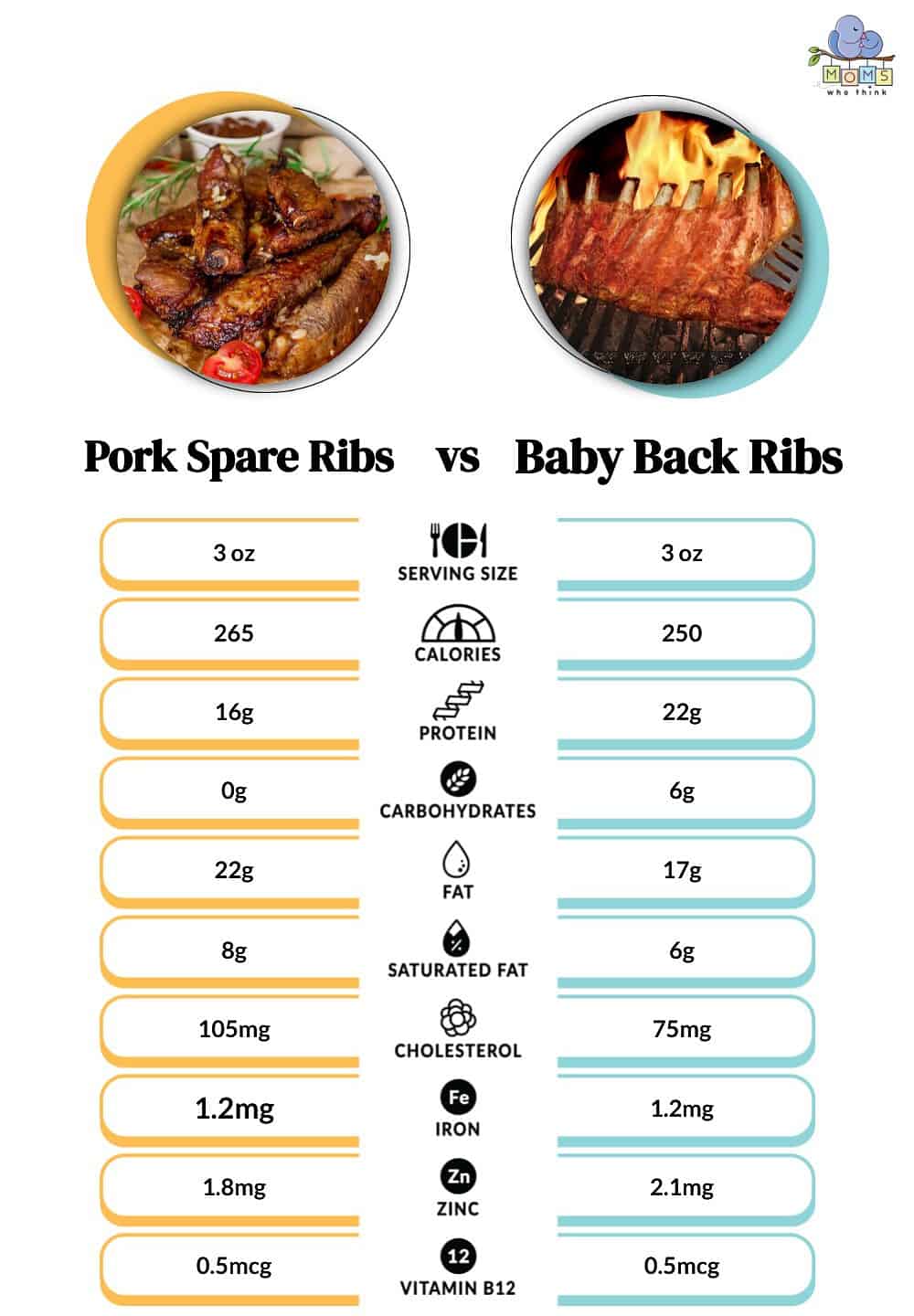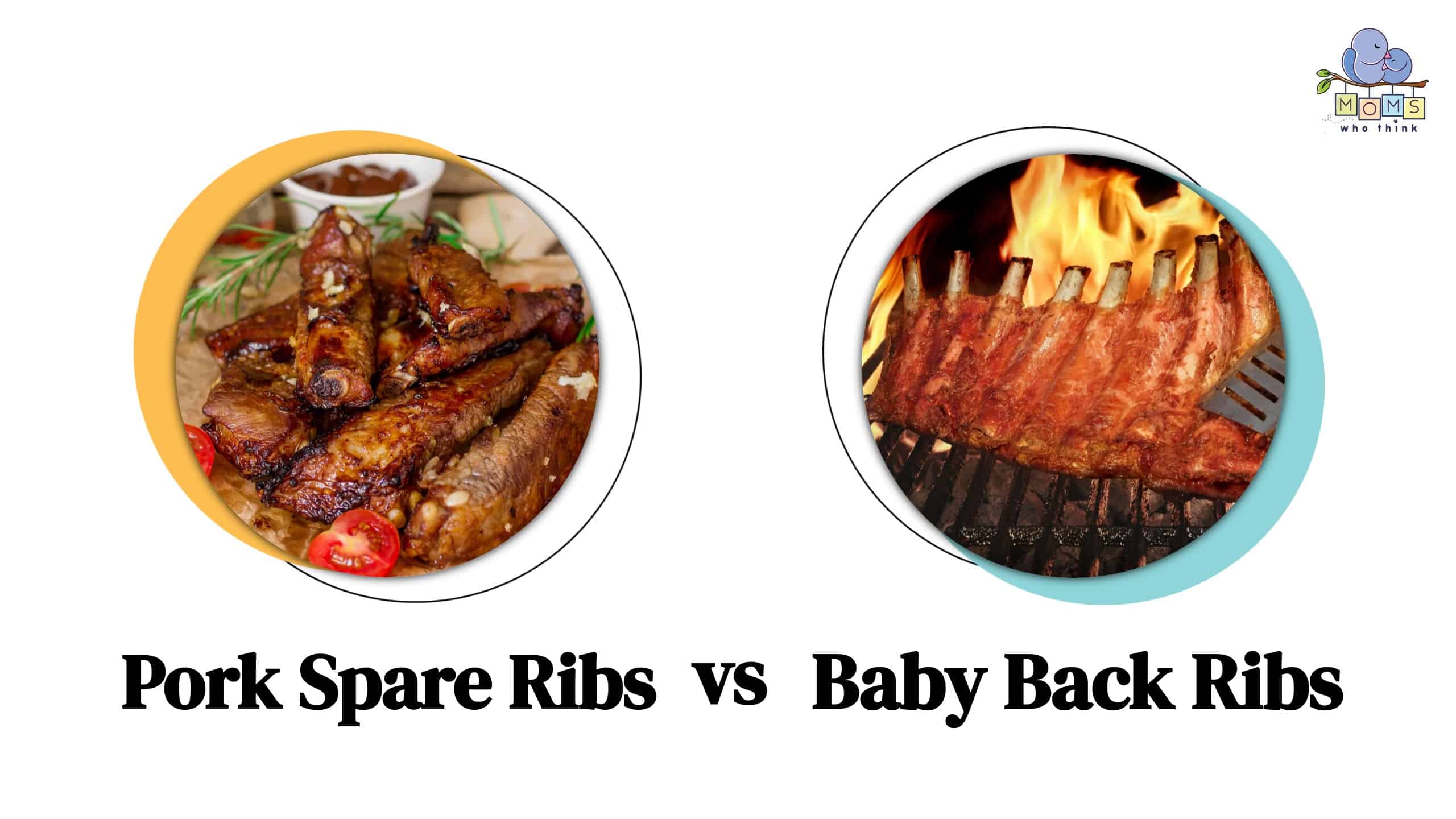If you’re looking for a tasty dinner dish, you can’t go wrong with either baby back or spare ribs, but what’s the difference? It comes down to size and where they come from in the pig. The differences between baby back ribs vs. spare ribs is that baby back ribs are smaller and more curved and are the leanest of the ribs, while spare ribs are meatier, larger, and they contain more fat and bone. Let’s dive deeper into this debate.
Baby Back Ribs vs. Spare Ribs: What are the Differences?
In order to truly understand the differences between baby back ribs vs. spare ribs, we first have to define each and look into what makes them unique.
What are Baby Back Ribs?
These ribs get this name because of their size. They’re smaller and have less meat than spare ribs. Overall, they’re leaner, more tender, and they have a steeper curve. Baby back ribs are taken from the upper rib cage of a pig, and they’re attached to the spare ribs and the backbone, which is why the word “back” is part of the equation. To show you how small they really are, an entire slab of ribs typically weighs about two pounds. The small size also allows for them to cook faster.
- The must-have convenient reference guide for every home cook!
- Includes more than 8,000 substitutions for ingredients, cookware, and techniques.
- Save time and money on by avoiding trips to grab that "missing" ingredient you don't really need.
Baby Back Rib Cooking Time
First, you need to prepare the ribs by removing the shiny membrane from the bone side because that will make them more tender. Next, apply a dry rub for flavor. Every rub is different but will generally include a variety of spices, like garlic powder, paprika, and black pepper. Apply this rub at least an hour before you start cooking, if not sooner. After that, you can apply your choice of BBQ sauce. The cooking time will differ based on how you prepare the ribs, but you’ll know they’re done when their internal temperature is 190 degrees Fahrenheit.
There are various ways to cook the ribs, and cooking times vary:
- Cook time for baby back ribs on a smoker: Five hours
- Cook time on a gas grill: 3.5 hours
- Charcoal grill: Three hours
- Cook time in an oven: Three hours
What are Spare Ribs?
Spare ribs are found in the rib section along the side and deeper into the belly of the pig. They are larger, meatier ribs that have well-defined bones and a greater amount of fat that adds to the flavor when cooked. A rack of 11 spare ribs will be hefty and will weigh about three pounds, which is more than the baby back ribs. However, spare ribs are different from baby back ribs because they have very little meat on top but instead have the meat between them, which is called flap meat. However, there’s a lot of meat there, and it tastes great.
Spare Rib Cooking Time
There are numerous ways that you can cook your spare ribs, and each method has its own cooking time. Many people like to prepare their ribs on a grill. If you do, preheat the grill. Start gas grills at least 10 minutes and charcoal grills about 40 minutes prior to cooking. Then, you can either choose to go for a quick cook, or you can take your time with slow cooking. Quick cooking may not have as much flavor, but you can grill each rib for two to three minutes each. You can get the most flavor by keeping them on the grill for one to two hours.
You can also smoke your ribs by adding mesquite briquettes on one side of the grill and heating them to about 325 degrees Fahrenheit. Then, add mesquite wood chips and additional briquettes as needed. All in all, it should cook for about 1.5 hours.
Baking ribs is another option. You’d preheat the oven to 275 degrees Fahrenheit and then add a cup of water to the bottom of the broiling pan. Cook the ribs in the pan for two hours or until the internal temp is 145 degrees Fahrenheit.
Finally, if you’re busy during the day and you want to get the most flavor out of your ribs, you can slow-cook them. Put them meat-side down in the slow cooker and let them work on low heat for six to eight hours.
5 Differences Between Baby Back Ribs vs. Spare Ribs
There are several differences to consider when choosing between spare ribs and baby back ribs for your next meal.
- The must-have convenient reference guide for every home cook!
- Includes more than 8,000 substitutions for ingredients, cookware, and techniques.
- Save time and money on by avoiding trips to grab that "missing" ingredient you don't really need.
1. Taste Difference
As far as the taste and meat distribution, there are some differences between the two meals. Baby back ribs have more meat near the top and on the surface of the rib, while spare ribs will have more meat in between each rib.
There are also differences with marbling. Baby back ribs have less fat, but they remain tender, mostly because they come from the pig’s loins. Spare ribs will generally be tougher, but they have a lot of marbling because they’re closer to the pig’s belly. The marbling makes the meat juicier and more tender. This is why most people will say that spare ribs tend to have more flavor than baby back ribs. Still, baby back ribs are more lean and tender, so it really comes down to personal preference.
2. Cost
There’s not a huge price difference when it comes to baby back ribs vs. spare ribs, and cost differences will often depend on the store. However, in many cases, you’ll find that baby back ribs are more expensive simply due to the demand. Although spare ribs are also delicious, restaurants like Chili’s have made baby back ribs a household name, so people often search for them in the grocery store.
3. Where They Come From
Baby back ribs are taken from the loins and the back of the pig, and they are meat that’s connected to the backbone under that lean muscle. Spare ribs are taken from along the pig’s breast bone, and they’re found at the end of the baby back ribs.
4. Size
A rack of baby back ribs will generally weigh about two pounds, while a rack of spare ribs will weigh slightly more at about three pounds. In both cases, most of the weight is due to the cartilage and bone instead of the actual meat.
5. Cooking Style
As you can see above, both types of ribs can have slightly different cooking styles. However, as a rule for both, add the sauce about 20 minutes before the ribs are done cooking. That will give the sauce time to caramelize into the meat. More than 20 minutes, and the sauce may burn. Also, in both cases, remove the silvery membrane from the back of the ribs.
6. Nutritional Differences
Although both types of ribs are similar from a nutritional standpoint, there are some differences to consider. They have some of the same nutrients, such as iron, zinc, and vitamin D. However, spare ribs have more fat and cholesterol but fewer carbs then baby back ribs.

©
Rib Recipes
Wherever you fall on the baby back ribs vs. spare ribs argument, we have many tasty recipes that you and your family are sure to love.
- Tangy Barbecue Ribs – Coat your spare ribs in sugar, rum, Worcestershire sauce, and black pepper for a flavor pop.
- Honey Glazed Baby Back Ribs – Put your baby back ribs to good use with this recipe that uses the perfect amount of honey, soy sauce, and BBQ sauce.
- Sticky Ribs – This recipe calls for boneless ribs, but with the right amount of garlic and brown sugar, they’re divine!
- Apricot Glazed Spare Ribs – Spare ribs are amazing when they’re cooked with garlic, onion, and a tasty apricot glaze.
- Ribs and Chicken – A general recipe that’s perfect for any family dinner.
Conclusion
As you can see, there are some differences between baby back ribs vs. spare ribs, especially when it comes to meat placement, weight, and preparation. Both are tasty options that will leave your diners feeling full and satisfied.
- The must-have convenient reference guide for every home cook!
- Includes more than 8,000 substitutions for ingredients, cookware, and techniques.
- Save time and money on by avoiding trips to grab that "missing" ingredient you don't really need.

